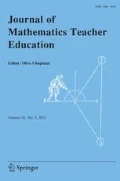Abstract
It is over 25 years since Wood, Bruner and Ross (1976, Journal of Child Psychology and Psychiatry, 17, 89–100) introduced the idea of ‘scaffolding’ to represent the way children’s learning can be supported. Despite problems, this metaphor has enduring attraction in the way it emphasises the intent to support a sound foundation with increasing independence for the learner as understanding becomes more secure. It has resonance with the widely accepted notion in teaching of construction and the constructivist paradigm for learning. The discussion that follows will characterise some teaching approaches that can be identified as scaffolding, revisiting some of the original classifications, and identifying further scaffolding strategies with particular reference to mathematics learning. Examples will be given from studies relating to geometry learning with four to 6 year olds and to arithmetic learning with older pupils.
Similar content being viewed by others
References
Anghileri J. (1995). Language, arithmetic and the negotiation of meaning. For the Learning of Mathematics 21(3):10–14
Anghileri J. (2000). Teaching number sense. Continuum, London
Anghileri J., Baron S. (1998). Playing with the materials of study: Poleidoblocs. Education 3–13 27(2):57–64
Anghileri J. (eds) (2001). Principles and practice in arithmetic teaching. Open University Press, Buckingham
Askew M., Brown M., Rhodes V., Wiliam D., Johnson D. (1997). Effective teachers of numeracy: Report carried out for the TTA. King’s College, London
Askew M., Wiliam D. (1995). Recent research in mathematics education 5-16. HMSO, London
Bliss J., Askew M., Macrae S. (1996). Effective teaching and learning: Scaffolding revisited. Oxford Review of Education 22(1):37–61
Cobb P., Boufi A., McClain K., Whitenack J. (1997). Reflective discourse and collective reflection. Journal for Research in Mathematics Education 28:258–277
Cobb, P., Wood, T., & Yackel, E. (1991). Classrooms as learning environments for teachers and researchers. In R. Davis, C. Maher & N. Noddings (Eds.), Constructivist views of the teaching and learning of mathematics. JRME monograph no. 4. Reston, VA: National Council of Teachers of Mathematics
Cobb P., Yackel E., McClain K. (eds) (2000) Communicating and symbolizing in mathematics, perspectives on discourse, tools and instructional design. Lawrence Erlbaum Associates, Mahwah, NJ
Coltman P., Anghileri J., Petyaeva D. (2002). Scaffolding learning through meaningful tasks and adult interaction, Early Years 22(1):39–49
Gravemeijer K., Cobb P., Bowers J., Whitenack J. (2000). Symbolizing, modeling and instructional design. In: Cobb P., Yackel E., McClain K. (eds) Communicating and symbolizing in mathematics, perspectives on discourse, tools and instructional design. Lawrence Erlbaum Associates, Mahwah, NJ
Hobsbaum A., Peters S., Sylva K. (1996). Scaffolding in reading recovery. Oxford Review of Education 22(1):17–35
Light P., Littleton P. (1999). Social practices in children’s learning. Cambridge University Press, Cambridge
McClain K., Cobb P., Gravemeijer K., Estes B. (1999). Developing mathematical reasoning within the context of measurement. In: Stiff L. (eds) Developing mathematical reasoning in Grades K-12. NCTM Yearbook 1999. National Council of Teachers of Mathematics, Reston, VA
Pimm D. (1987). Speaking mathematically. Routledge, London
Qualifications and Curriculum Authority. (QCA) (1999). Teaching written calculation strategies. Her Majesty Stationary Office, London
Rogoff B. (1995). Observing sociocultural activity on three planes: Participatory appropriation, guided participation, and apprenticeship. In: Wertsch J., del Rio P., Alvarez A. (eds) sociocultural studies of mind. Cambridge University Press, New York, NY
Rogoff B., Mistry J., Goncu A., Mosier C. (1993). Guided participation in cultural activity by toddlers and caregivers. University of Chicago Press, Chicago, IL
Rogoff B., Wertsch J. (1984). Children’s learning in the ‘zone of proximal development’. Jossey-Bass, San Francisco
Tharpe R., Gallimore R. (1988). Rousing minds to life: Teaching, learning, and schooling in social context. Cambridge University Press, Cambridge
van Oers B. (2000). Learning mathematics as a meaningful activity. In: Steffe L., Nesher P. (eds) Theories of mathematical learning. Lawrence Erlbaum, Mahwah, NJ, pp. 91–113
Wood T. (1994). Patterns of interaction and the culture of mathematics classrooms. In: Lerman S. (ed) Cultural perspectives on the mathematics classroom. Kluwer, Dordrecht
Wood D., Bruner J., Ross G. (1976). The role of tutoring in problem solving. Journal of Child Psychology and Psychiatry 17:89–100
Author information
Authors and Affiliations
Corresponding author
Rights and permissions
About this article
Cite this article
Anghileri, J. Scaffolding practices that enhance mathematics learning. J Math Teacher Educ 9, 33–52 (2006). https://doi.org/10.1007/s10857-006-9005-9
Published:
Issue Date:
DOI: https://doi.org/10.1007/s10857-006-9005-9




